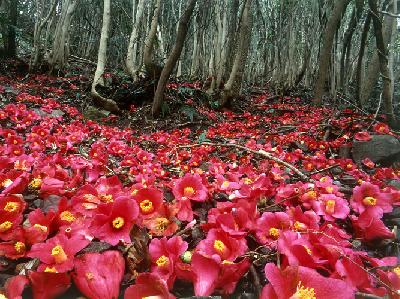落椿 Otitubaki Fallen Camellia
|
Fallen camellia is one of the spring season words in haiku, or 5-7-5 poems. Camellia japonica is a major evergreen broadleaf tree which flowers from winter to the beginning of spring.
The camellia flower does not fall separately as petals, but as a complete flower from its root. It was said that after the Meiji period, samurais hated the camellia because of the way it appeared to drop from the neck. In fact, it was already being propagated in the Edo period.
The flower is both beautiful and useful, so it has been famous since the time of 'Collection of a Myriad Leaves' (750). In modern ages, it was loved as a tea flower and many garden varieties were invented. It has also been featured in art and music.
In the 18th century, a Jesuit sub-cenobite, G.J. Kamel obtained its seeds in the Philippines and introduced it to Europe. In ‘The Lady of the Camellias,’ the novel written by Alexandre Dumas fils, it appears as the flower loved by the leading character.
The camellia flower does not fall separately as petals, but as a complete flower from its root. It was said that after the Meiji period, samurais hated the camellia because of the way it appeared to drop from the neck. In fact, it was already being propagated in the Edo period.
The flower is both beautiful and useful, so it has been famous since the time of 'Collection of a Myriad Leaves' (750). In modern ages, it was loved as a tea flower and many garden varieties were invented. It has also been featured in art and music.
In the 18th century, a Jesuit sub-cenobite, G.J. Kamel obtained its seeds in the Philippines and introduced it to Europe. In ‘The Lady of the Camellias,’ the novel written by Alexandre Dumas fils, it appears as the flower loved by the leading character.
- name
- Fallen Camellia












